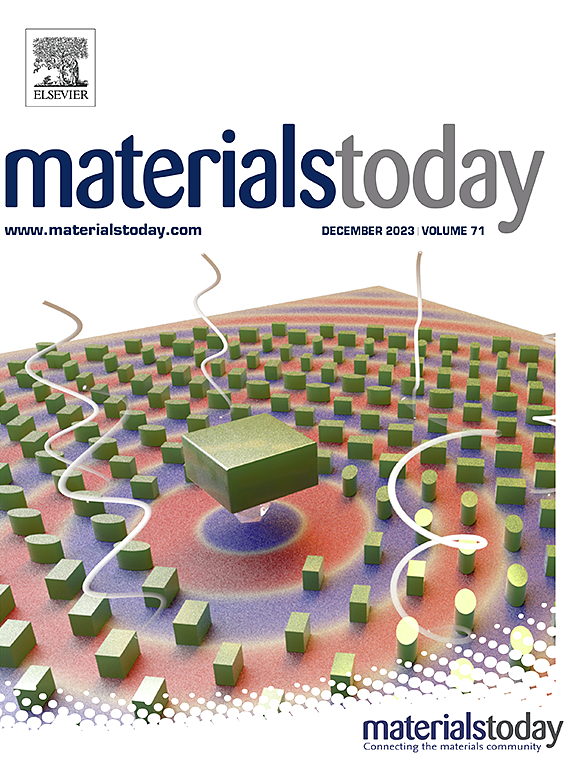Wireless electronic-free mechanical metamaterial implants
IF 21.1
1区 材料科学
Q1 MATERIALS SCIENCE, MULTIDISCIPLINARY
引用次数: 0
Abstract
Wireless force sensing in smart implants enables real-time monitoring of mechanical forces and facilitates dynamic adjustments to optimize implant functionality in-situ. This capability enhances the precision of diagnostics and treatment, leading to superior surgical outcomes. Despite significant advancements in wireless smart implants over the last two decades, current implantable devices still operate passively and require additional electronic modules for wireless transmission of stored biological data. To address these challenges, we propose an innovative wireless force sensing paradigm for implantable systems through the integration of mechanical metamaterials and nano energy harvesting technologies. We demonstrate composite mechanical metamaterial implants capable of serving as all-in-one wireless force sensing units, incorporating functions for power generation, sensing and transmission with ultra-low power requirements. In this alternative communication approach, the electrical signals harvested by the implants from mechanical stimuli are utilized directly for the wireless transmission of the sensed data. We conduct experimental and theoretical studies to demonstrate the wireless detection of the generated strain-induced polarization electric field using electrodes. The feasibility of the proposed wireless force sensing approach is evaluated through a proof-of-concept orthopedic implant in the form of a total knee replacement. The findings indicate that the created wireless, electronic-free metamaterial implants with a power output as low as 0.1 picowatts enable direct, self-powered wireless communication during force sensing across air, simulated body fluid and animal tissue. We validate the functionality of the proposed implants through a series of experiments conducted on an ex vivo human cadaver knee specimen. Furthermore, the effect of electrode size and placement on the strength of the received signals is examined. Finally, we highlight the potential of our approach to create a diverse array of mechanically-tunable implants capable of precise force measurements and wireless real-time data transmission, all without relying on any external antennas, power sources, or telemetry systems.

无线无电子机械超材料植入物
智能植入物中的无线力传感能够实时监测机械力,并促进动态调整,以优化植入物的原位功能。这种能力提高了诊断和治疗的准确性,导致了更好的手术结果。尽管无线智能植入物在过去二十年中取得了重大进展,但目前的植入设备仍然是被动运行的,并且需要额外的电子模块来无线传输存储的生物数据。为了解决这些挑战,我们提出了一种创新的植入式系统无线力传感范例,通过集成机械超材料和纳米能量收集技术。我们展示了复合机械超材料植入物,能够作为一体化的无线力传感单元,具有超低功耗要求的发电、传感和传输功能。在这种替代通信方法中,植入物从机械刺激中获得的电信号被直接用于感测数据的无线传输。我们进行了实验和理论研究,证明了利用电极对产生的应变极化电场进行无线检测。通过全膝关节置换术形式的概念验证骨科植入物来评估所提出的无线力传感方法的可行性。研究结果表明,所创造的无线、无电子的超材料植入物的输出功率低至0.1皮瓦,可以在空气、模拟体液和动物组织的力传感过程中实现直接、自供电的无线通信。我们通过在离体人类尸体膝关节标本上进行的一系列实验来验证所提出的植入物的功能。此外,还研究了电极尺寸和放置位置对接收信号强度的影响。最后,我们强调了我们的方法的潜力,创造了各种各样的机械可调植入物,能够精确的力测量和无线实时数据传输,所有这些都不依赖于任何外部天线,电源或遥测系统。
本文章由计算机程序翻译,如有差异,请以英文原文为准。
求助全文
约1分钟内获得全文
求助全文
来源期刊

Materials Today
工程技术-材料科学:综合
CiteScore
36.30
自引率
1.20%
发文量
237
审稿时长
23 days
期刊介绍:
Materials Today is the leading journal in the Materials Today family, focusing on the latest and most impactful work in the materials science community. With a reputation for excellence in news and reviews, the journal has now expanded its coverage to include original research and aims to be at the forefront of the field.
We welcome comprehensive articles, short communications, and review articles from established leaders in the rapidly evolving fields of materials science and related disciplines. We strive to provide authors with rigorous peer review, fast publication, and maximum exposure for their work. While we only accept the most significant manuscripts, our speedy evaluation process ensures that there are no unnecessary publication delays.
 求助内容:
求助内容: 应助结果提醒方式:
应助结果提醒方式:


